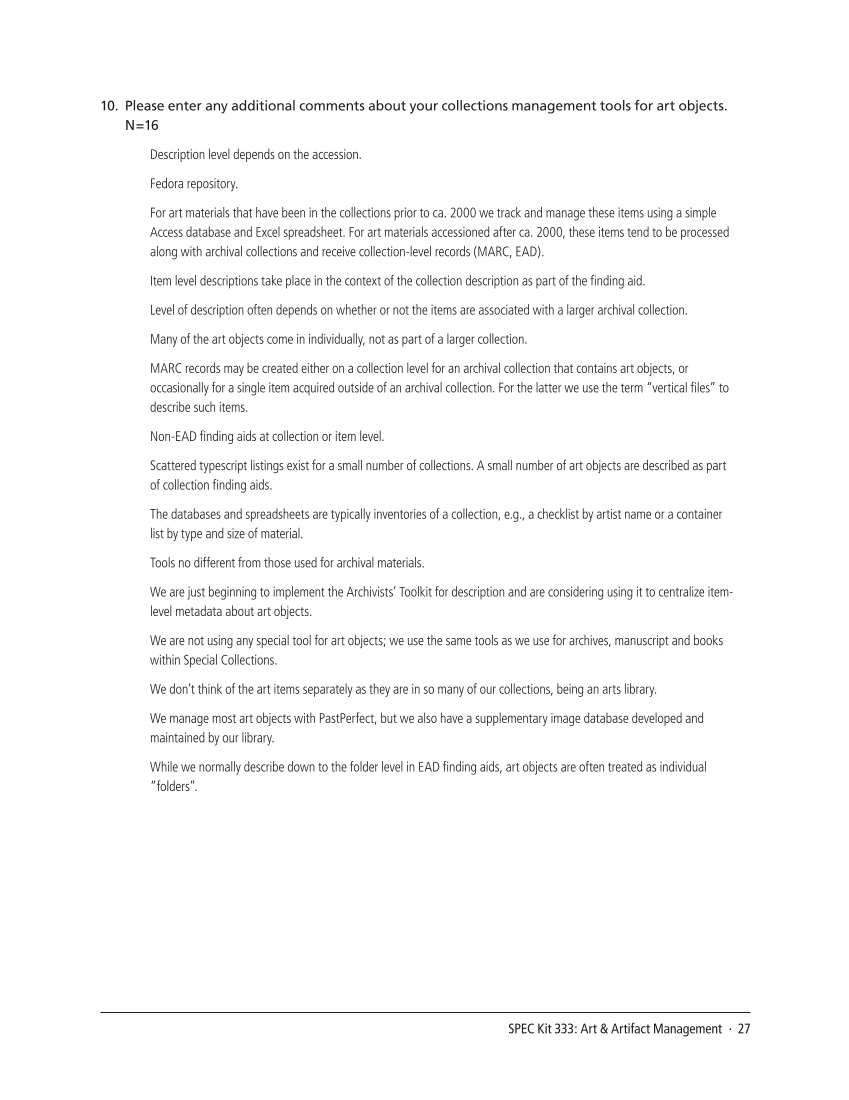SPEC Kit 333: Art &Artifact Management · 27
10. Please enter any additional comments about your collections management tools for art objects.
N=16
Description level depends on the accession.
Fedora repository.
For art materials that have been in the collections prior to ca. 2000 we track and manage these items using a simple
Access database and Excel spreadsheet. For art materials accessioned after ca. 2000, these items tend to be processed
along with archival collections and receive collection-level records (MARC, EAD).
Item level descriptions take place in the context of the collection description as part of the finding aid.
Level of description often depends on whether or not the items are associated with a larger archival collection.
Many of the art objects come in individually, not as part of a larger collection.
MARC records may be created either on a collection level for an archival collection that contains art objects, or
occasionally for a single item acquired outside of an archival collection. For the latter we use the term “vertical files” to
describe such items.
Non-EAD finding aids at collection or item level.
Scattered typescript listings exist for a small number of collections. A small number of art objects are described as part
of collection finding aids.
The databases and spreadsheets are typically inventories of a collection, e.g., a checklist by artist name or a container
list by type and size of material.
Tools no different from those used for archival materials.
We are just beginning to implement the Archivists’ Toolkit for description and are considering using it to centralize item-
level metadata about art objects.
We are not using any special tool for art objects we use the same tools as we use for archives, manuscript and books
within Special Collections.
We don’t think of the art items separately as they are in so many of our collections, being an arts library.
We manage most art objects with PastPerfect, but we also have a supplementary image database developed and
maintained by our library.
While we normally describe down to the folder level in EAD finding aids, art objects are often treated as individual
“folders”.
10. Please enter any additional comments about your collections management tools for art objects.
N=16
Description level depends on the accession.
Fedora repository.
For art materials that have been in the collections prior to ca. 2000 we track and manage these items using a simple
Access database and Excel spreadsheet. For art materials accessioned after ca. 2000, these items tend to be processed
along with archival collections and receive collection-level records (MARC, EAD).
Item level descriptions take place in the context of the collection description as part of the finding aid.
Level of description often depends on whether or not the items are associated with a larger archival collection.
Many of the art objects come in individually, not as part of a larger collection.
MARC records may be created either on a collection level for an archival collection that contains art objects, or
occasionally for a single item acquired outside of an archival collection. For the latter we use the term “vertical files” to
describe such items.
Non-EAD finding aids at collection or item level.
Scattered typescript listings exist for a small number of collections. A small number of art objects are described as part
of collection finding aids.
The databases and spreadsheets are typically inventories of a collection, e.g., a checklist by artist name or a container
list by type and size of material.
Tools no different from those used for archival materials.
We are just beginning to implement the Archivists’ Toolkit for description and are considering using it to centralize item-
level metadata about art objects.
We are not using any special tool for art objects we use the same tools as we use for archives, manuscript and books
within Special Collections.
We don’t think of the art items separately as they are in so many of our collections, being an arts library.
We manage most art objects with PastPerfect, but we also have a supplementary image database developed and
maintained by our library.
While we normally describe down to the folder level in EAD finding aids, art objects are often treated as individual
“folders”.


















































































































































































